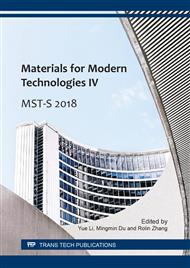p.99
p.105
p.111
p.119
p.128
p.134
p.141
p.149
p.157
Molecular Dynamics Simulation of Ultrathin Perfluoropolyether Lubricant Depletion under Moving Laser Heating
Abstract:
In this work, molecular dynamics simulations of nanostructured perfluoropolyether (PFPE) lubricants were performed to investigate the depletion instability under rapid scanning laser heating. A modified coarse-gained model was utilized to represent the random copolymer structures of PFPEs. In the simulation, only a partial lubricant near the substrate was irradiated by the laser beam to mimic the nano-scale heat transfer from disk to lubricant. During the laser heating, the surface morphological changes of the PFPE lubricant indicated that the lubricant beads initially raise up and diffuse due to thermal expansion, and then evaporate and form circular ridges around the laser beam center, leading to aggravated depletion. Moreover, the lubricant decomposition was subtle and regarded as negligible; while the raised ridges around the depletion area signified that the non-equilibrium thermo-capillary stress plays an important role in lubricant depletion. The surface temperature contour profiles of the lubricant were evaluated as well. It was showed that the increased temperature is centered around the laser beam and quickly decays toward the ambient temperature, forming non-concentric oval shape distributions and ultrahigh lateral thermal gradients. In addition, the maximum temperature (up to 990 K) was also examined and it is consistent with the ones required by HAMR systems to achieve areal densities beyond 1 Tb/in2.
Info:
Periodical:
Pages:
128-133
Citation:
Online since:
May 2018
Keywords:
Price:
Сopyright:
© 2018 Trans Tech Publications Ltd. All Rights Reserved
Share:
Citation:


